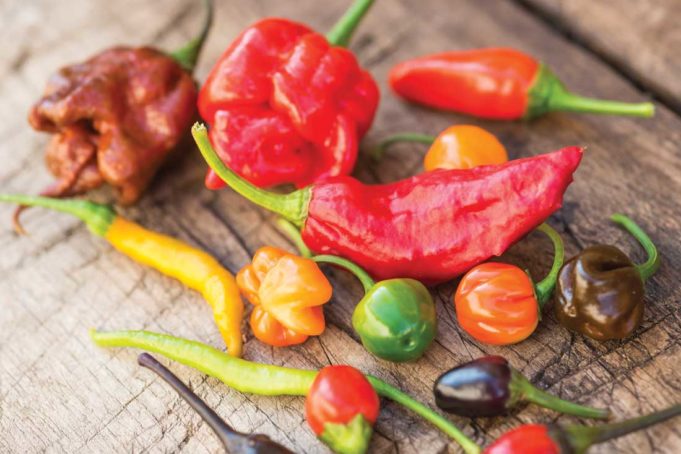Whether you’re a food writer or you just like food, you know that there’s probably some kind of food “holiday” any day of the year. January 14 is International Hot and Spicy Food Day, which proves that those of us who love eats and drinks will celebrate just about any damn thing.
The heat in a pepper is calibrated on a scale called Scoville heat units (SHU). Banana peppers, paprika, and pimentos come in at under 1,000 SHU. Mexican condiments like poblanos run over 3,000 SHU, while the jalapeño can hit up to 20,000 SHU. Habanero chiles and scotch bonnet peppers can top 300,000 SHU. Ghost pepper chiles (bhut jolokia, to use the name from India, where it’s from) used to be the hottest in the world, scorching in at about a million SHU.
The Ghost Pepper Challenge found thousands of people wolfing down the eponymous pepper, sometimes on purpose, and then weeping, gagging, and calling to Jesus in the hope that the pain would go away.
But ghost peppers are so 2010. Currently the hottest pepper on the planet is the Carolina Reaper, crossbred in South Carolina by someone who apparently wanted to start some chemical warfare. The angry red pepper packs a SHU rating of 2 million and a wickedly evil tail that looks like a stinger. For perspective, the Reaper is as strong as commercial-grade pepper spray, which is definitely not edible.
Predictably, there’s a Carolina Reaper challenge, too.
In no particular order of hot and spicy yumminess, here are some options to help you sweat your way through Saturday, Jan. 14.
At Angie’s Bikkles, the lovely Maureen “Angie” Hucey serves up Jamaican dishes that aren’t dumbed down for American palates. The jerk chicken and her goat or chicken curries are hotter than an average Indian curry (probably toward that 300,000 SHU) but not Reaper hot. A traditional Jamaican sorrel will cool off your taste buds nicely.
There are very few Korean restaurants in Tarrant County, which makes HoYa Kitchen stand out. Really traditional kimchee is usually strong enough to clear your sinuses and possibly your neighbor’s as well because of its pungent fermentation. The kimchee at HoYa isn’t fully fermented, but it still packs a punch. And the gochujang, a sweetly spicy chile-based sauce that’s a little like sriracha, runs at about 3,000 SHU. A little rice will help cool the burn.
At Chef Jesus Garcia’s Oni Ramen, you can get your ramen broth spiced to order – mild, medium, hot, “fire,” and “demon” – with a blend of scorpion and ghost peppers (both about a million on the SHU). Our reviewer broke a sweat with Garcia’s level-three hot version. Or you can just go for the Oni Reaper – the demon pepper miso broth with pork belly, bamboo, corn, noodles, green onion, and an egg on top.
Thai Charm is a delightfully traditional restaurant that’s worth the drive to Haltom City. Thai cuisine relies on ground and fresh peppers like the Bird’s Eye chile, about 200,000 on the SHU. When you order dishes like Pad Thai, you select from a numbered scale (usually 1-5) in which the first number is the mildest and the highest number is “Thai spicy.” If I’m by myself, I get a 3- or a 4-level spice because I love the juxtaposition of the intense heat with the sweet and sour spices. If I’m eating with someone who’s spice averse, I get the dish spiced at 2. The Level 2 spice at Thai Charm was like a 3 or a 3-and-a-half anywhere else.
Finally, the wild habanero salsa at Wild Salsa was fiery reddish-orange, which should have been a warning about the heat content of the thick, pasty condiment. It’s served in a ramekin as part of a salsa appetizer trio. The habanero’s searing 300,000 SHU power makes this dish just too spicy to consume more than a dab. Sadly, a standard size chip coated in the sauce was just a bit too much for me but maybe not for someone with iron taste buds.
And in case you need it, the best remedies to counteract food that’s too spicy include a shot of dairy, a bit of sugar or honey, lemon or lime, starch (like bread or rice), or some fat or oil. Maybe that’s why the Thai and Korean foods work so well – your pepper’s bathed in noodles or rice, and there’s usually sweet and sour condiments too. The worst thing you can do if you run into a Carolina Reaper is drink alcohol, water, or caffeine, which will dilute but not eliminate the spice. Good luck, and spice safely.












